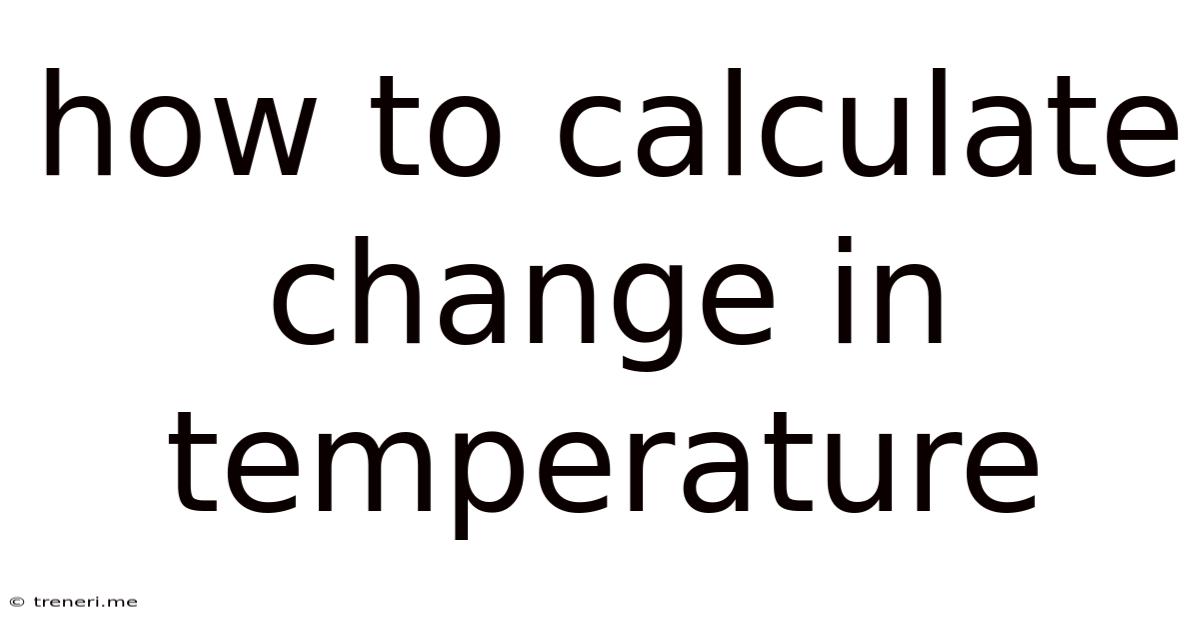How To Calculate Change In Temperature
Treneri
May 09, 2025 · 4 min read

Table of Contents
How to Calculate Change in Temperature: A Comprehensive Guide
Calculating changes in temperature might seem straightforward, but understanding the nuances and different scenarios is crucial for accuracy and application in various fields. This comprehensive guide will delve into various methods, formulas, and considerations involved in calculating temperature changes, catering to different levels of understanding and application.
Understanding Temperature Scales
Before we dive into calculations, let's refresh our understanding of temperature scales. The most commonly used scales are Celsius (°C), Fahrenheit (°F), and Kelvin (K). Each scale has a different zero point and increment size, making conversion crucial for accurate calculations involving changes across different scales.
Key Differences and Conversions:
-
Celsius (°C): Based on the freezing and boiling points of water at 0°C and 100°C respectively. Widely used internationally for scientific purposes and everyday life.
-
Fahrenheit (°F): Primarily used in the United States. Water freezes at 32°F and boils at 212°F.
-
Kelvin (K): The absolute temperature scale, where 0 K represents absolute zero – the theoretical point where all molecular motion ceases. This scale is crucial in scientific contexts, particularly thermodynamics.
Conversion Formulas:
- Celsius to Fahrenheit: °F = (°C × 9/5) + 32
- Fahrenheit to Celsius: °C = (°F - 32) × 5/9
- Celsius to Kelvin: K = °C + 273.15
- Kelvin to Celsius: °C = K - 273.15
Calculating Change in Temperature: Basic Methods
The simplest calculation involves finding the difference between two temperatures. This is done by subtracting the initial temperature from the final temperature.
Formula:
ΔT = T<sub>final</sub> - T<sub>initial</sub>
Where:
- ΔT represents the change in temperature
- T<sub>final</sub> is the final temperature
- T<sub>initial</sub> is the initial temperature
Example:
If the initial temperature is 25°C and the final temperature is 35°C, the change in temperature is:
ΔT = 35°C - 25°C = 10°C
This indicates a 10°C increase in temperature. If the final temperature was lower, the result would be a negative value, indicating a temperature decrease.
Calculating Change in Temperature with Different Units
When dealing with temperatures in different units, conversion is necessary before calculating the change. Failing to convert can lead to significant errors.
Example:
Let's say the initial temperature is 77°F, and the final temperature is 104°F. To calculate the change in temperature in Celsius:
-
Convert to Celsius:
- T<sub>initial</sub> (°C) = (77°F - 32) × 5/9 = 25°C
- T<sub>final</sub> (°C) = (104°F - 32) × 5/9 = 40°C
-
Calculate the change:
- ΔT = 40°C - 25°C = 15°C
Therefore, the temperature increased by 15°C.
Advanced Calculations: Considering Specific Heat Capacity
In many real-world applications, calculating temperature change involves considering the specific heat capacity of the substance. Specific heat capacity (c) is the amount of heat required to raise the temperature of 1 gram of a substance by 1 degree Celsius (or 1 Kelvin).
Formula:
Q = mcΔT
Where:
- Q represents the heat energy transferred (in Joules)
- m represents the mass of the substance (in grams)
- c represents the specific heat capacity of the substance (in J/g°C or J/gK)
- ΔT represents the change in temperature
This formula allows us to calculate the heat energy required to cause a specific temperature change or, conversely, determine the temperature change resulting from a given amount of heat energy.
Example:
Let's say we want to heat 100g of water (c = 4.18 J/g°C) from 20°C to 80°C. The heat energy required would be:
Q = (100g) × (4.18 J/g°C) × (80°C - 20°C) = 25080 J
Applications and Practical Considerations
Calculating temperature changes is fundamental across numerous disciplines:
-
Meteorology: Tracking weather patterns, forecasting, and climate change analysis rely heavily on accurate temperature measurements and change calculations.
-
Engineering: Designing efficient heating and cooling systems, material science, and chemical processes necessitate precise temperature calculations.
-
Cooking: Understanding temperature changes is crucial for successful cooking and baking.
-
Medicine: Monitoring body temperature and its changes are essential in diagnosing and treating illnesses.
Factors Influencing Temperature Changes:
-
Heat Transfer: Temperature changes are primarily driven by heat transfer through conduction, convection, and radiation. Understanding these mechanisms is vital for accurate calculations.
-
Environmental Factors: External factors such as air pressure, humidity, and solar radiation can significantly impact temperature changes.
-
Phase Changes: Phase transitions (e.g., melting, boiling) involve significant energy changes and require specific calculations beyond simple ΔT.
Conclusion: Mastering Temperature Change Calculations
Calculating changes in temperature is a fundamental skill applicable across various scientific and everyday contexts. Understanding the different temperature scales, employing the correct formulas based on the available information, and considering factors like specific heat capacity are crucial for accurate and reliable results. By mastering these techniques, you'll enhance your problem-solving skills and deepen your comprehension of thermal processes. Remember to always double-check your units and conversions to avoid errors. With practice, you'll become proficient in handling temperature change calculations with confidence.
Latest Posts
Latest Posts
-
How Many Days Til Dec 18
May 10, 2025
-
Lcm Of 5 7 And 2
May 10, 2025
-
How Large Is 20 Square Feet
May 10, 2025
-
12 Out Of 17 As A Grade
May 10, 2025
-
What Is 2 95 Expressed As A Fraction
May 10, 2025
Related Post
Thank you for visiting our website which covers about How To Calculate Change In Temperature . We hope the information provided has been useful to you. Feel free to contact us if you have any questions or need further assistance. See you next time and don't miss to bookmark.